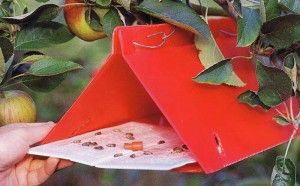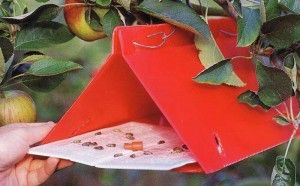Monitoring pests and diseases is a fundamental first step in creating a proper IPM program.
Targeting pests at the right time and with the right product, can save money, make pest management programs more effective, and can help preserve beneficial insects and mites.
There are many ways to monitor for insect pests, and one very popular way is using pheromone traps.
 Pheromone traps
Pheromone traps
Pheromone traps are NOT the only method you should use to monitor for any pest. They are a useful tool but they are not a stand-alone method.
Relying solely on pheromone traps for your monitoring information can be risky to your crop!
Having said that, pheromone traps are a useful tool but need to be used correctly. If you are in an area where there is a regional monitoring service available, you can rely on that for general guidelines, but you will need to monitor your own farm as well.
Pheromones
Pheromones are chemicals produced by some species of insects (probably in more species than we now know) to communicate with members of the same species.
Frequently these are ‘sex pheromones’ which a female produces to attract a mate. Pheromones are most well known for Lepidoptera—moths and butterflies like Codling Moth, Oriental Fruit Moth and Light Brown Apple Moth.
For pheromone trap use, synthesised pheromone chemicals are forced into a rubber ‘septa’ (a small rubber cap), which is placed in a sticky trap to attract male moths into the traps where they get caught on the sticky surface.
The numbers you record from pheromone traps can tell you when a particular pest is present in the adult form in your area (useful to determine a Biofix, or simply presence or absence of the pest).
Recording the trap catches will give you information on population trends, including peak activity. In either case, this information can help you determine the best timing for applying necessary control measures.
However, the information you obtain is only as good as the procedure and servicing of traps. Proper use of pheromone traps includes careful storage and handling of lures, consideration of placement in the orchard, replacement of traps and lures as required, and consistent monitoring of traps.
In summary
- Handle and store pheromone lures appropriately or they will not be effective.
- Lures need to be kept in their sealed packages until ready for use, and should be stored in the refrigerator or freezer as directed by the manufacturer.
- Use tweezers or gloves to handle the lures to avoid cross-contamination with lures of different species.
- Replace lures as directed—they don’t last all season!
- Place traps far enough apart so that they don’t interfere with one another; about 50 m apart.
- Never place more than one lure in each trap. Make sure you use the recommended numbers to effectively cover the area which is being monitored.
- Service your traps and replace them when sticky pads are no longer sticky.
- Be able to identify your target pest.
- Monitor faithfully, regularly and keep good records.
Storage and handling
Pheromone ‘caps’ (lures) should be left in their sealed packages until a day before use in the field.
Pheromone blends are species-specific and insects are sensitive to minute quantities of pheromones.
When handling pheromone lures (or any other pheromone product), wear disposable gloves or use tweezers to avoid cross-contamination with other products.
Pheromone lures should be stored in their sealed packages in a fridge until use, unless directed otherwise by the manufacturer.
Placement in the field
Sticky traps should be hung before the lures are placed in them.
Put the traps at least 50 m apart and if you are trapping for more than one kind of insect, use separate traps for each kind of lure and keep them at least 50 m from any traps set up for monitoring other species (see Table 1).
Mark the location of the traps with bright flagging tape around the butt of the tree. Label your traps as well, especially if you are monitoring for different insect species at the same site.
Always use different traps for each insect type that you are monitoring—do not use more than one kind of lure per trap.
Replacement
If traps get full of dirt, other insects or leaf bits, they should be changed. The pheromone lure can be transferred to the new sticky base.
Lures last for different lengths of time; if a replacement time is not printed on the package, assume that they last about six weeks, down to four weeks in hot dry areas.
Pheromone lures definitely do not last all season! Try to replace the lures between generations of the monitored pest.
Monitoring the traps
Scrape out moths and other insects with a small scraper. Make sure you know what insect you are looking for and record the numbers you find every time. Do not rely on your memory!
If you are not sure EXACTLY what your target insect looks like, find out. Local agronomists can either identify your catches or direct you to good reference material for insect identification.
The reason that this is so important is that even though pheromones are species specific, traps do sometimes catch other insects passively (they’re just flying through).
Record your trap catches every time and graph the numbers if you can—it helps to visualize what the numbers mean.
Interpreting the numbers
The numbers you record from pheromone trap catches tell you a couple of things about the pest but don’t expect them to give you the whole picture.
They do tell you when a particular pest is present in the adult form in your area. That’s important for some pests, as is ‘biofix’ or sustained first flight for other pests.
By graphing the total numbers caught in your traps on each monitoring day, you can also see whether the numbers of adults is rising or falling. This can help you determine the best timing for control measures.
The numbers caught in your traps do not always tell you enough information about the overall pest pressure to be used as thresholds for action.
Timing of sprays is most accurate when information is gathered from a number of sites—regional monitoring programs are extremely useful for this.
Example
Using the three pests from Table 1 as examples, here is a rough idea of how to use the information from pheromone trap catches to time control sprays.
(Note: if you are using mating disruption products for control of any pests, this information does not apply to you).
Insecticide sprays are directed towards newly hatched larvae, not the adults.
For both OFM and CM, some decisions are not based on pheromone trap data.
Monitoring in other ways for these and all pests is a vital part of pest management.
For OFM, treatment should occur some days after peak flight depending on the weather (especially temperature—for first generation in the spring, the timing may be weeks after the first flight or days after peak flight, but only a few days for later generations).
First generation LBAM may not cause economic damage except in sites with a history of severe infestations.
The first insecticide for second generation LBAM is timed for a number of days after the first significant upswing in trap catches for that generation.
Third generation flight activity is often sporadic, so border sprays can be applied when traps indicate activity.
Don’t worry if there are moths still being caught in your traps after a spray is used.
Your spray for most moths is targeted at the new larvae as they emerge from their egg. Adult moths will still be flying from other locations and males will continue to be caught in your traps. That is not an indication that there was any problem with the effectiveness of your spray.
When you’re not sure what the numbers mean, seek guidance from experienced agronomist or pest management specialists.
Summary
- Handle and store pheromone lures appropriately or they will not be effective.
- Replace traps and lures when needed and do not expect lures to work for a whole year.
- Place the traps so that they do not interfere with each other or with traps for other insects.
- Monitor faithfully and regularly and keep careful records.
- Be able to identify your target pest and find out what other common insects look like.
- Do not rely on trap catch numbers alone for pest management decisions.
Special note for growers using mating disruption products
Pheromone traps have a very different use if you are treating your entire orchard with pheromones for mating disruption (MD) of a particular pest.
Of course they won’t work—or at least they should not catch any moths in a pheromone treated area.
The pheromone dispensers fill the surrounding area with pheromones, making it hard for males to find females and also making it hard for males to find the lures.
That is exactly why you should still use the traps—as an indirect measure that the MD is working! Do not rely on trap catches alone to be sure that MD is protecting your field!
We cannot stress that point enough. Remember, the traps are for catching males, they tell you nothing about the number of mated females that may be flying in from elsewhere.
Regular, careful monitoring for signs of crop damage is imperative to be sure your site is protected.
Actually, that’s good advice for everyone, not just those using MD products.
With CM in MD orchards, the extra strong 10 mg lure overrides the MD dispensers.
Unfortunately these do not work for OFM.
Bait traps are used in MD blocks for monitoring OFM. These are a food lure, so attract both, male and female moths.
For a series of photos and contact details, see the September 2012 issue of Tree Fruit




















